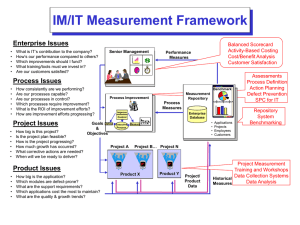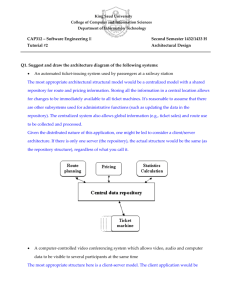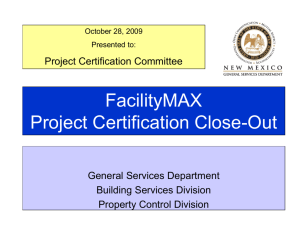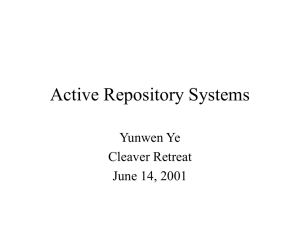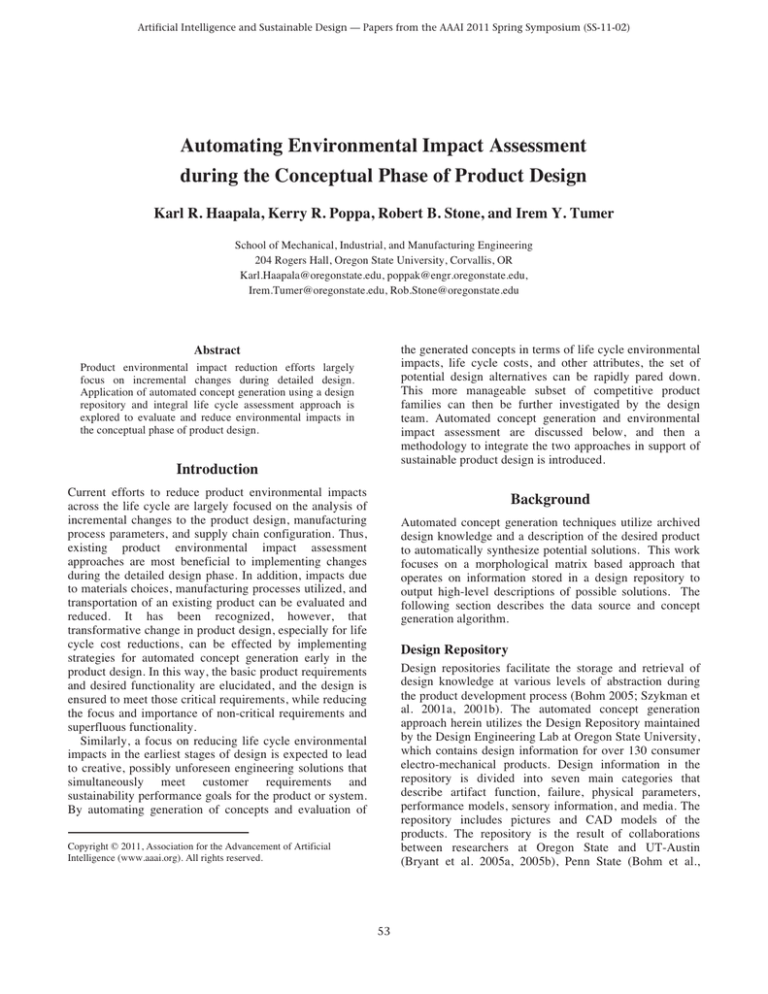
Artificial Intelligence and Sustainable Design — Papers from the AAAI 2011 Spring Symposium (SS-11-02)
Automating Environmental Impact Assessment
during the Conceptual Phase of Product Design
Karl R. Haapala, Kerry R. Poppa, Robert B. Stone, and Irem Y. Tumer
School of Mechanical, Industrial, and Manufacturing Engineering
204 Rogers Hall, Oregon State University, Corvallis, OR
Karl.Haapala@oregonstate.edu, poppak@engr.oregonstate.edu,
Irem.Tumer@oregonstate.edu, Rob.Stone@oregonstate.edu
the generated concepts in terms of life cycle environmental
impacts, life cycle costs, and other attributes, the set of
potential design alternatives can be rapidly pared down.
This more manageable subset of competitive product
families can then be further investigated by the design
team. Automated concept generation and environmental
impact assessment are discussed below, and then a
methodology to integrate the two approaches in support of
sustainable product design is introduced.
Abstract
Product environmental impact reduction efforts largely
focus on incremental changes during detailed design.
Application of automated concept generation using a design
repository and integral life cycle assessment approach is
explored to evaluate and reduce environmental impacts in
the conceptual phase of product design.
Introduction
Current efforts to reduce product environmental impacts
across the life cycle are largely focused on the analysis of
incremental changes to the product design, manufacturing
process parameters, and supply chain configuration. Thus,
existing product environmental impact assessment
approaches are most beneficial to implementing changes
during the detailed design phase. In addition, impacts due
to materials choices, manufacturing processes utilized, and
transportation of an existing product can be evaluated and
reduced. It has been recognized, however, that
transformative change in product design, especially for life
cycle cost reductions, can be effected by implementing
strategies for automated concept generation early in the
product design. In this way, the basic product requirements
and desired functionality are elucidated, and the design is
ensured to meet those critical requirements, while reducing
the focus and importance of non-critical requirements and
superfluous functionality.
Similarly, a focus on reducing life cycle environmental
impacts in the earliest stages of design is expected to lead
to creative, possibly unforeseen engineering solutions that
simultaneously meet customer requirements and
sustainability performance goals for the product or system.
By automating generation of concepts and evaluation of
Background
Automated concept generation techniques utilize archived
design knowledge and a description of the desired product
to automatically synthesize potential solutions. This work
focuses on a morphological matrix based approach that
operates on information stored in a design repository to
output high-level descriptions of possible solutions. The
following section describes the data source and concept
generation algorithm.
Design Repository
Design repositories facilitate the storage and retrieval of
design knowledge at various levels of abstraction during
the product development process (Bohm 2005; Szykman et
al. 2001a, 2001b). The automated concept generation
approach herein utilizes the Design Repository maintained
by the Design Engineering Lab at Oregon State University,
which contains design information for over 130 consumer
electro-mechanical products. Design information in the
repository is divided into seven main categories that
describe artifact function, failure, physical parameters,
performance models, sensory information, and media. The
repository includes pictures and CAD models of the
products. The repository is the result of collaborations
between researchers at Oregon State and UT-Austin
(Bryant et al. 2005a, 2005b), Penn State (Bohm et al.,
Copyright © 2011, Association for the Advancement of Artificial
Intelligence (www.aaai.org). All rights reserved.
53
2006), Virginia Tech, Bucknell (Shooter et al., 2005),
University of Buffalo, Drexel, and Texas A&M.
Collaborations have expanded the types of design
information and breadth of design tool features within the
repository. A standalone application supports information
entry and retrieval (Bohm et al. 2007), while a web portal
(http://repository.designengineeringlab.org)
enables
information retrieval on the web.
are seen as insignificant, or rely upon process databases
(Todd and Curran 1999). Once process inputs and outputs
are determined, known as the life cycle inventory (LCI),
the level of environmental impact for each process is
assessed using a variety of methods, e.g., Cumulative
Energy Demand and Eco-indicator 99 (Hischier and
Weidma 2009). The final phase of LCA is improvement
analysis, which identifies the most impactful processes and
the parameters that cause the greatest change in predicted
impacts. This allows targeted modifications to be made to
product or process designs.
While LCA is best suited for comparative analyses of
existing products or proposed design modifications,
product and process information contained within the
Design Repository and LCI databases can be used in
tandem to evaluate the potential environmental impact of
automatically generated, or virtual, concepts.
Automated Concept Generator
Information stored in the repository can be used by
automated concept generation techniques to transform a
functional description of a desired product into assemblies
of components. The concept generation algorithm used in
this work, Morphological Evaluation Machine and
Interactive Conceptualizer (MEMIC), translates the input
functional model into a function adjacency matrix. This
adjacency matrix undergoes a series of matrix
multiplications that map functionality to solutions and
filters out infeasible component-to-component connections
based on repository data. The output of MEMIC is a set of
concept variants that solve the input functionality (Bryant
et al. 2005b). The methodology described below would use
an evolution of this tool as its concept generation
algorithm. After concepts have been generated, repository
data can be used to predict a number of their performance
attributes including environmental sustainability metrics.
Related Work in Early Design Life Cycle
Assessment
A significant body of existing research focuses on LCA
approaches that can be applied early in the design process.
Eisenhard et al. (2000) have demonstrated a method in
which neural networks are implemented to develop
approximate impact assessments during the early stages of
design. This approach relies upon parametric LCA models
to define particular classes of products. The neural
network is then used to find similarities between a new
design and existing designs. Kraines et al. (2006) have
developed a knowledge-based system that leverages
ontologies to merge expert knowledge into a single
platform. Kraines’ use of ontologies facilitates the transfer
of knowledge between disparate disciplines engaged in
both the design process and impact assessment.
Park and Seo also make use of a knowledge-based
system to approximate life cycle assessments of a
particular design (Park and Seo 2006). Their system, the
Knowledge-based Approximate Life Cycle Assessment
System, makes it easier for designers to implement LCA
during early phases of design; however, the input requires
CAD representations of the artifacts comprising the overall
design. Another knowledge-based approach takes the form
of a Decision Support Problem (Bras and Mistree 1991).
The DSP technique seeks to suggest more complete design
information when a designer specifies an open ended or
unstructured artifact.
An approach more similar to the method explored by the
authors is shown by Gehin et al. (2007) and focuses on the
way component choice determines a product’s total
environmental impact. They develop an approach using
LCA to evaluate end of life impacts that treats the product
impact as a sum of component impacts. However, a
limitation of their assessment approach is the exclusion of
unknown parameters by assuming they are similar for each
alternative. Our approach described below would form a
more complete evaluation based on stored data from
existing products.
Product Environmental Impact Assessment
Product environmental sustainability is often judged in a
comparative manner among competing alternatives based
on functional equivalency, e.g., operational life or
performance level, using life cycle assessment (LCA)
(Haapala et al. 2008). Environmental impacts are based on
the type, source, and amount of input materials and energy,
as well as concomitant wastes and emissions, for each
stage of the product life cycle. Life cycle stages include
material extraction and processing, component and product
manufacturing, use, and end of life. Often, transport of
materials and products is considered as a separate stage. A
diagram of the product life cycle is shown in figure 1.
Typically, input/output models are devised to represent
each unit process involved at each stage of the product life
cycle. Model development can involve significant effort
and time, thus, to facilitate analysis, practitioners may
focus only on specific life cycle stages, omit processes that
Material
Extraction
Material
Processing
Recycling
Product
End of Life
Product
Manufacture
Product
Use
Remanufacturing
Reuse
Figure 1 The Product Life Cycle
54
Devanathan et al. (2009) have developed a technique
that is also similar to our methodology. Their efforts
assign life cycle impacts to product functions, focusing
designer attention on elements of product function most
tied to life-cycle impact. In our methodology, we take the
approach that life cycle impacts are primarily determined
by the way the specified functionality is achieved, so we
estimate the impacts associated with particular component
choice. Whether it is best to regard life cycle impact as
related to component choice or specified functionality, is
still an open question. A third possibility that should be
explored in future work is that impacts are properties of the
interaction of component type and functionality. More
accurate estimates are expected by considering impact as a
property of a particular component type performing a
particular function rather than as a property of the
component type or function alone.
Prior work by the authors evaluating kitchen appliances
demonstrated that environmental impacts of virtual
concepts are indicative of final product impacts (Bohm et
al. 2010). There were several limitations noted, however.
The quantity and quality of data available in the design
repository directly affected the adequacy of results in
representing the final product. In fact, actual products
performing the same function were variable in
composition. Material data was often reported in terms of
bounded volume, rather than mass, raising concern about
scaling these measures to an accurate material mass. The
data was best suited to cradle-to-gate analysis, since use
phase, e.g., energy consumption and failure rate, and endof-use information was sparse.
Proposed Methodology
The remainder of this paper discusses our vision for a
methodology to integrate LCA into the automated concept
generation process, and current work in addressing these
limitations initially by focusing on data in the repository;
and later through improved data collection and quality, and
subsequent data analysis. Efforts will investigate the
scalability to better evaluate the correlation of bounding
volume and material mass. In addition, product data will be
studied to determine key sources and modes of failure.
Failed components will cause additional environmental
impacts due to production and end-of-use effects and this
information can be used to help designers assess tradeoffs
between cradle to gate impact and impact due to repair or
early retirement of the product due to failure.
We propose and have begun to investigate a five-step
methodology for integrating life cycle assessment and
automated concept generation, as described below.
Step 1. Functional Modeling
First, the designer develops a functional description of
the required product. This description is translated into a
functional model that describes the intended products
operations on flows of matter, energy, and information.
Based on the concept generation tool and design repository
used, the functional model must be created using the
Functional Basis (Stone and Wood 2000; Hirtz, et al.
2002). An example of such a model for a hypothetical
kitchen appliance for heating water is shown in figure 2. A
functional model, once generated, is a graph that can be
transformed into an adjacency matrix and understood by
concept generation software.
Figure 2 Example Functional Model
55
much greater confidence surrounds the material data within
the repository than in the manufacturing process data.
Predictions must include not only the processes chosen
but also estimates of part features related to those
processes, e.g., the length of a welded joint, the mass of
material machined away, or the length of a bend. At
present, this information is not recorded in the repository.
The initial implementation of the proposed method will be
based on a set of standard values for these parameters that
are representative of consumer scale electromechanical
products. Combining the manufacturing process – as
predicted from the repository in the same manner as mass
and material – with standard feature parameters, an
estimate of overall impact due to manufacturing process
can be calculated using Eco-indicator 99 or similar impact
assessment methods.
Finally, the individual estimates for impact due to
material and process for each component of the concept
can be summed to produce an impact estimate for the
concept. The process is then repeated to arrive at estimates
for each of the generated concepts. Thus, the impact
estimates are representative of the cradle to grave
environmental impacts of each concept and form a basis
for comparison.
Other important factors such as
transportation, energy inputs, and use phase impacts are
not yet considered, but will be explored in feature
iterations of the proposed method.
Step 2. Automated Concept Generation
In the second step of the proposed method, the designer
supplies the generated functional model as an adjacency
matrix to the automated concept generator. The tool then
performs an automated version of Zwicky’s morphological
analysis (Zwicky 1969). The tool queries the repository
for past instances of products exhibiting the desired
functionality and returns all components known by the
database to have solved each function. Concepts can then
be generated by selecting one element from each row of
this morphological matrix. Such an approach necessarily
implies a combinatorial explosion of possible solutions,
many of which will be infeasible. To reduce the incidence
of infeasible solutions, a second query of the database is
conducted to assess component compatibility. The tool
rejects any solution that is made up of components that are
not together in a previously recorded product. Concept
generation is halted based on a termination condition that
can either be a fixed number of concepts or the drop in
concept-to-concept variation below a specified threshold.
Concepts are output as component adjacency matrices that
can be used to estimate life cycle impacts and failure and
reliability concerns.
Step 3. Estimation of Life Cycle Impacts
The proposed method next estimates the cradle to gate life
cycle impact of the generated concepts based on data
stored in the repository and values provided by the Ecoindicator 99 impact assessment method. To construct an
environmental impact estimate for each concept, the
required amount of material used and manufacturing
processes utilized must be predicted to produce each of the
components used in the concept.
Each component of the products archived in the
repository is tagged with the material or materials from
which it was constructed. As a baseline, the material of the
component used to build the concept can be predicted from
this set. The designer would specify, based on the
application, whether to estimate the material based on a
best, worst, or average case material. In addition to
material type, the amount of material required must also be
predicted. Mass and volume data are recorded for artifacts
in the repository, so an estimate for the composition of the
new component can be predicted from prior instances of
components of the same type. Again, as for the material
prediction, the designer would choose to have the estimates
calculated based on a best, worst, or average case.
Estimation of manufacturing process proceeds in a
similar fashion, but with a key added complication; the
predicted process must be appropriate for the material
predicted. Thus, the likely manufacturing processes found
for components of the specified type with the predicted
material are queried. It should be noted that this process
can also proceed in the opposite manner.
The
manufacturing process can be predicted first, and then the
material choice constrained accordingly. We will proceed
in the former manner for an initial implementation because
Step 4. Predictions of Failure Modes
One important additional dimension that can be considered
under this method is the reliability of the product. A
product whose production represents a small impact on the
environment may be a less attractive choice if it is likely to
fail earlier and require replacement more often than
another alternative. As with material, mass, manufacturing
process, and other parameters, the repository can store
information about the failure modes of products. The
authors have previously used this information to predict
likely failure modes in conceptual products (Grantham
Lough et al. 2009; Stone et al. 2005; Tumer and Stone
2003). Thus, these methods can be used to predict the
likely failure modes and their likelihood and severity for
each concept, which in turn can be used to predictively
estimate environmental impacts for each alternative on a
functional unit basis (e.g., total operational life).
Step 5. Analysis of Results and Presentation to the
Designer
The many generated concepts and their predicted
environmental impact and failure performance are
presented to the designer for further analysis and selection.
In practice, the number of concepts will exceed the number
a human designer could reasonably be expected to evaluate
manually. The proposed method would then employ
unsupervised machine learning tools to cluster groups of
similar component selection, predicted impact, and failure
56
characteristics. Representative samples of each cluster can
then be displayed to the designer to guide their search.
Results generally fall into three categories. First are
solutions that are attractive, perhaps because of novelty,
but which have poor environmental impact or failure
characteristics. Based on the application of the proposed
methodology, a designer choosing to pursue these concepts
is forearmed with the knowledge of potential problems and
can take action during embodiment and detailed design of
the concept to mitigate these issues.
A second category is concepts with low environmental
impact, but undesirable failure characteristics, or vice
versa. The designer, based on application of the proposed
methodology is made aware of the potential tradeoffs
between impact and reliability and longevity of the
product. The tradeoffs can be assessed in light of the
designers experience and knowledge of the problem under
consideration. As before, the designer is forearmed to take
necessary steps to mitigate potential problems during later
stages of design.
The third expected category captures solutions that have
desirable environmental impact and failure characteristics.
These can be presented to the designer as likely candidates
for further exploration. Understanding why they have
better predicted performance than competing concepts is
expected to assist the designer in adapting and enhancing
other concepts, especially those deemed more desirable on
a functional basis or those that are more attractive from
other perspectives (e.g., novelty and aesthetics).
type or alloy. As a first effort to capture cradle to gate
environmental impacts, we propose adjusting the
repository schema to use the Eco-indicator 99 list of
materials as a fixed vocabulary for future efforts.
Process data is more difficult to use as currently
recorded in the design repository and points to necessary
changes to its database to accommodate automated
estimation of environmental impacts.
For instance,
processes recorded do not align well with processes
identified in the Eco-indicator 99 manual. The current
repository records only a small subset of the processes
considered by Eco-indicator 99. A major concern is that
for the majority of artifacts only a single primary
manufacturing process is identified. A reality, reflected by
the manual is that real products are produced using a
variety of shaping, joining, and finishing processes. The
current repository data entry application should be
amended to encourage the recording of all relevant
processes used to produce each artifact.
Another key data deficiency relates to artifact features.
To estimate the impact of a stamped metal part, for
example, it is necessary to know the area of material
deformed. This data regarding parameters of component
features has traditionally not been recorded in the
repository, and the current schema lacks a convenient
location to store it. For an initial implementation of the
proposed method, representative values can be established
for use in analysis cases. However, moving forward, the
repository schema will have to be amended to add the
ability to capture manufacturing process data if reasonable
impact estimates are to be automatically calculated.
Many of these results point toward the need for an
intelligent data entry tool that can prompt users to supply
necessary and appropriate information about artifacts as
they are entered. Such a tool could restrict the possible
manufacturing processes based on recorded material, or
prompt the user to specify correct parameters based on
material and process. While such an effort is separate from
the proposed methodology; our initial exploration
emphasizes the need for such an intelligent data entry tool.
State of Available Data
Before embarking on the development of a tool to
implement the proposed methodology, we consider the
ability of the data currently recorded in the aforementioned
design repository to meet our requirements. The following
section summarizes the data available and notes key
shortcomings and opportunities for future development.
Material and Process Data
A generated concept is represented as a set of components
and their connections with one another. We will estimate
the impact of manufacturing a particular concept as the
sum of the impacts of its components. Prior work by the
authors has has validated that reasonable estimates can be
made, but this analysis would require significant manual
analysis of the data by the user. To automatically calculate
an estimate, the data must correspond to material and
processing options with impact values.
We found that, in general, there is good correspondence
between the material and process options in Eco-indicator
99 and the materials and processes recorded in the
repository. All materials recorded in the repository from
previous analysis of kitchen appliances are listed in the
Eco-indicator 99 manual, however some are recorded at
too abstract a level to be used. For example some artifacts
are recorded as simply being metal rather than a particular
Mass Data and Scaling
A key finding in earlier work was that mass data for many
important artifact types was missing. To overcome this
limitation, the artifact volume and the density of its
constituent materials were used to compute a mass
estimate. Recorded volume tended to be represented as a
bounding box rather than the actual volume, so a scaling
factor was needed. A suitable scaling factor was found for
the classes of products studied.
If a suitable scaling factor could be found for other
classes of products or components, then the proposed work
could proceed without tackling the problem of limited
mass data. To asses this possibility, the repository was
queried for all components with both mass and volume
data. For each component, the actual recorded mass was
compared to that obtained by multiplying its bounding box
volume (also reported) by the material density. These
57
scaling factors where aggregated to find mean and variance
of scaling factor for each component type. Mean scaling
factors ranged from 0.01 to slightly less than 3. The inter
component data was also characterized by high variance.
This analysis suggests that a widely applicable scaling
factor cannot be found based on data currently in the
repository.
Given that a consistent scaling factor could not be found
for all cases, the possibility that a single scaling factor
could adequately represent some clusters of component or
material type was then investigated. No strong evidence
for such a trend in the data was found, though we suspect
that there should be some level of similarity between
related components and materials. We surmise that the
lack of such a pattern is due in part to the small sample size
of some component types in the repository. The absence
of an agreeable scaling factor for all artifacts, or even
groups of similar artifacts, suggests that the using volume
data and density is not a viable solution to estimating
component mass. Instead, actual mass data must be used,
and greater effort must be placed on ensuring this data is
recorded when products are entered into the database.
components to proceed with development of the proposed
method and associated tool. Figure 3 shows the state of
this data in the repository. The axes show the percentage
of instances of each component type with the desired data,
while the size of the bubble indicates the population of that
component type. While sample sizes are in general small,
we find that there is sufficient data to proceed with a
preliminary study. Data will continue to be recorded to
increase the population of underrepresented components.
Conclusion
Life cycle assessment of automatically generated concepts
will enable product development that evaluates and
reduces environmental impacts from the earliest stages of
design. The proposed approach will allow environmental
impact analysis, and ultimately other sustainability
considerations, to become a component of automated
conceptual design. The method, and a tool to implement it,
will enable intelligent aides that enhance the designer’s
ability to understand risks and tradeoffs related to
environmental impact and reliability early in the process.
This enables more rapid development of more
environmentally sound products with fewer redesign
cycles, and facilitates the consideration of important life
cycle issues early in design when significant gains can still
be made at relatively low cost.
Availability of Mass and Failure Data
Finally, the availability of sufficient samples of component
types was investigated. Of particular concern was ensuring
that there was enough mass and failure data for common
#%
!
"
$$
!"
&
!
"
!
%"
"
#
""
#
!
%
""%
"
#
!
"
"
%
"
!
""
#
% "
!
$
,
Figure 3 Summary of Available Mass and Failure Data within the Design Repository
58
and Evolving Previous Efforts, Research in Engineering Design,
13(2), pp. 65-82.
References
Bohm, M. R., K. R. Haapala, K. Poppa, A. Nix, R. B. Stone, I. Y.
Tumer. 2010. Integrating Life Cycle Assessment into the
Conceptual Phase of Design to Aid Decision Making. Journal of
Mechanical Design: Special Issue on Sustainable Design. 132(9),
091005, 12 pp.
Hischier, R. and Weidma, B. 2009. Implementation of Life Cycle
Impact Assessment Methods, Final Report. ecoinvent v2.1 No. 3,
S.C.f.L.C. Inventories, St. Gallen, Switzerland.
Kraines, S., Batres, R., Kemper, B., Koyama, M., and Wolowski,
V. 2006. Internet-Based Integrated Environmental Assessment,
Part II: Semantic Searching Based on Ontologies and Agent
Systems for Knowledge Discovery, Journal of Industrial
Ecology, 10(4): 37-60.
Bohm, M., J. Vucovich, and R. Stone. 2007. An Open Source
Application for Archiving Product Design Information, Proc.
ASME International Design Engineering Technical Conferences
DETC2007-35401: Las Vegas, NV.
Park, J.-H. and Seo, K.-K. 2006. A Knowledge-Based
Approximate Life Cycle Assessment System for Evaluating
Environmental Impacts of Product Design Alternatives in a
Collaborative Design Environment, Advanced Engineering
Informatics, 20: 147-154.
Bohm, M. R., Stone, R. B., Simpson, T. W., and Steva, E. D.
2006. Introduction of a Data Schema: The Inner Workings of a
Design Repository, Proc. ASME International Design
Engineering Technical Conferences, Philadelphia, PA.
Bohm, M., R. Stone, and S. Szykman. 2005. Enhancing Virtual
Product Representations for Advanced Design Repository
Systems. Journal of Computer and Information Science in
Engineering. 5(4): p. 360-372.
Shooter, S., Simpson, T., Kumara, S., Stone, R., and Terpenny, J.
2005. Toward a Multi-Agent Information Management
Infrastructure for Product Family Planning and Mass
Customisation. International Journal for Mass Customisation,
1(1): p. 134-155.
Bras, B. and Mistree, F. 1991. Designing Design Processes in
Decision-Based Concurrent Engineering,” Journal of Materials &
Manufacturing, 100: 451-458.
Stone, R., and Wood, K. 2000. Development of a Functional
Basis for Design, Journal of Mechanical Design, 122(4), pp. 359370.
Bryant, C., McAdams, D., Stone, R., Kurtoglu, T., and Campbell,
M. 2005a. A Computational Technique for Concept Generation,
Proceedings of IDETC/CIE 2005, Long Beach, CA, DETC200585323.
Stone, R. B., Tumer, I. Y., and Van Wie, M. 2005. The FunctionFailure Design Method, Journal of Mechanical Design, 127(3),
pp. 397-407.
Bryant, C., Stone, R., McAdams, D., Kurtoglu, T., and Campbell,
M. 2005b. Concept Generation from the Functional Basis of
Design, Proc. International Conference on Engineering Design,
ICED 05, Melbourne, Australia
Szykman, S., R. Sriram, and W. Regli. 2001a. The Role of
Knowledge in Next-generation Product Development Systems.
Journal of Computer and Information Science in Engineering,
1(1): p. 3-11.
Devanathan, S., Koushik, P., Zhao, F., and Ramani, K. 2009.
Integration of Sustainability into Early Design through Working
Knolwedge Model and Visual Tools, 2009 ASME International
Manufacturing
Science
and
Engineering
Conference,
MSEC2009-84356, West Lafayette, IN.
Szykman, S., Fenves, S., Shooter, S., and Keirouz, W.,2001b. A
Foundation for Interoperability in the Next-Generation Product
Development Systems, Computer-Aided Design, 33(7), pp. 545559.
Todd, J.A. and Curran, M.A. 1999. Streamlined Life Cycle
Assessment: A Final Report from the SETAC North American
Streamlined LCA Workgroup. Pensacola, FL: SETAC and
SETAC Foundation for Environmental Education.
Eisenhard, J.L., Wallace, D., Sousa, I., Schepper, M., and
Rombouts, J. 2000. Approximate Life-Cycle Assessment in
Conceptual Product Design, ASME 2000 Design Engineering
Technical Conferences and Computers and Information in
Engineering Conference, DETC2000/DFM-14026, Baltimore,
MD.
Tumer, I. Y., and Stone, R. B. 2003. Mapping Function to Failure
During High-Risk Component Development, Research in
Engineering Design, 14(1), pp. 25-33
Gehin, A., Zwolinski, P., and Brissaud, D. 2007. Towards the Use
of LCA During the Early Design Phase to Define EoL Scenarios,
Proceedings of the 14th CIRP Conference on Life Cycle
Engineering - Advances in Life Cycle Engineering for Sustainable
Manufacturing Businesses, Tokyo, Japan.
Zwicky, F., 1969. Discovery, Invention, Research - through the
Morphological Approach, Macmillian Company, Toronto.
Grantham Lough, K., Stone, R., and Tumer, I. Y. 2009. The Risk
in Early Design Method, Journal of Engineering Design, 20(2),
pp. 115-173.
Haapala, K. R., J. L. Rivera, and J. W. Sutherland. 2008.
Application of Life Cycle Assessment Methods to Sustainable
Product Design and Manufacturing. International Journal of
Innovative Computing, Information and Control: Special Issue on
Recent Advances in Flexible Automation. 4(3), pp. 575-589.
Hirtz, J., Stone, R., McAdams, D., Szykman, S., and Wood, K.
2002. A Functional Basis for Engineering Design: Reconciling
59

